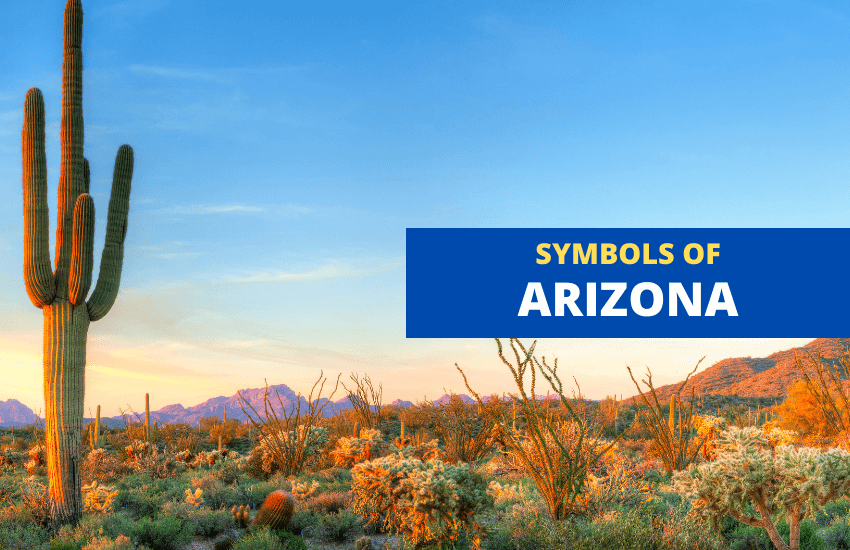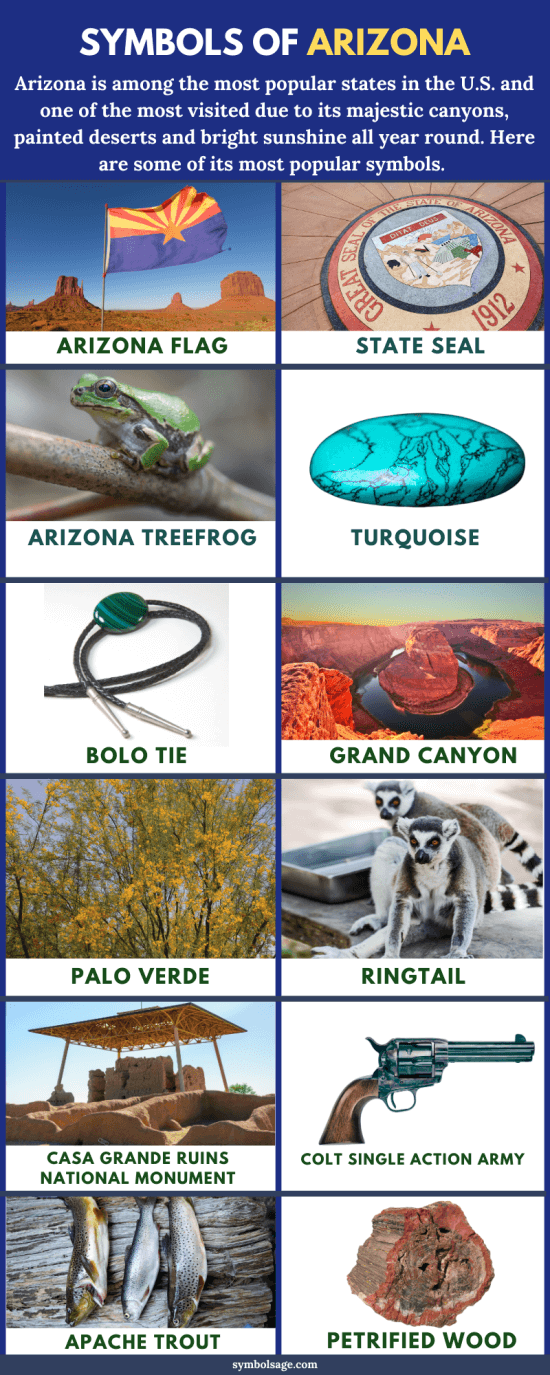
Table of Contents
Arizona is among the most popular states in the U.S. and one of the most visited due to its majestic canyons, painted deserts and bright sunshine all year round. The state is home to some of the biggest celebrities in the world including Twilight author Stephenie Myer, Doug Stanhope and WWE star Daniel Bryan. Arizona is full of beautiful places to visit and fun activities to take part in.
Originally a part of New Mexico, Arizona was later ceded to the U.S. in 1848 and became its own separate territory. It’s the 48th state to be admitted to the Union, achieving statehood in 1912. Here’s a look at some of the state symbols of Arizona.

Flag of Arizona
The state flag of Arizona was designed by the Adjutant General of Arizona Territory, Charles Harris in 1911. He designed it on the spur of the moment for a rifle team that needed a flag to represent them in a competition in Ohio. The design later became the official flag of the state, adopted in 1917.
The flag depicts a five-pointed gold star in the centre with 13 red and gold beams radiating from behind it. The beams represent the original 13 colonies and the sun setting over the Western Desert. The gold star symbolizes the copper production of the state and the blue field on the lower half is the ‘liberty blue’ seen on the U.S. flag. The colors blue and gold are also the official state colors of Arizona.
Seal of Arizona
The Great Seal of Arizona contains symbols of Arizona’s main enterprises as well as its attractions and natural resources. It features a shield in the centre within which is a mountain range in the background, with the sun rising behind its peaks. There’s also a lake (a storage reservoir), irrigated orchards and fields, grazing cattle, a dam, a quartz mill and a miner holding a shovel and pick in either hand.
At the top of the shield is the state motto: ‘Ditat Deus’ which means ‘God Enriches’ in Latin. Around it are the words ‘Great Seal of the State of Arizona’ and on the bottom is ‘1912’, the year Arizona became a U.S. state.
The Grand Canyon
The Grand Canyon State is Arizona’s nickname, as much of the Grand Canyon is located in the Grand Canyon National Park in Arizona. This stunning natural landscape is among the most unique in the world, attracting millions of tourists every year.
The formation of the canyon was caused by erosion from the Colorado river and the lifting up of the Colorado plateau, a process which took over 6 million years. What makes the Grand Canyon so significant is that the layered bands of rock contain billions of years of the Earth’s geological history, which can be observed by visitors.
The Grand Canyon was considered a sacred site by certain Native American tribes, who would make pilgrimages to the place. There’s also evidence that pre-historic native Americans lived within the canyon.
Arizona Tree Frog
The Arizona tree frog is found in the mountains of both central Arizona and in western New Mexico. Also known as the ‘mountain frog’, it grows to about 3/4” to 2” in length and is usually green in color. However, it can also be gold or bronze with a white belly.
Arizona tree frogs are primarily nocturnal and they spend most of the year inactive, just like most amphibians do. They feed on insects, dense grass or shrubs and can be heard vocalizing during the early part of the rainy season. It’s only the male frogs that vocalize, making clacking sounds.
If it gets frightened, the frogemits a high-pitched screech that’s terrifying to the ears so it should ideally never be touched. In 1986, this local tree frog was designated the official amphibian of the state of Arizona.
Turquoise
Turquoise is one of the oldest known gemstones, opaque and blue-to-green in color. In the past, it was used by Native Americans of southwestern U.S. and Mexico to make beads, carvings and mosaics. It’s the state gemstone of Arizona, designated in 1974. Arizona turquoise is famous around the world for its exceptional quality and unique hue. The state is currently the most important turquoise producer by value and several turquoise mines exist in the state.
Bola Tie
The bola (or ‘bolo’) tie is a necktie made of a piece of braided leather or cord with decorative metal tips fasted to an ornamental slide or clasp. The official neckwear of Arizona, adopted in 1973, is the silver bola tie, adorned with a turquoise (the state gemstone).
However, the bola tie comes in a wide range of styles and has been an important part of Navajo, Zuni and Hopi traditions since the mid-twentieth century. It’s said that bola ties were created by North American pioneers in 1866 but a silversmith in Wickenburg, Arizona claims to have invented it in the 1900s. Therefore, the actual origin of the bola tie remains a mystery to this day.
Copper
Arizona is famous for its copper production, higher than that of any other state in the U.S. In fact, 68 percent of all the copper produced in the nation comes from the state of Arizona.
Copper is a soft, ductile and malleable metal with high electrical and thermal conductivity. It’s one of the few metals that occur in nature in a metallic, directly usable form which is why it was used by humans as early as 8000 BC.
Since copper is the cornerstone of the state’s history and economy, it was chosen as the official state metal by Senator Steve smith in 2015.
Palo Verde
The palo verde is a type of tree native to Southwestern U.S. and designated the official state tree of Arizona back in 1954. Its name is Spanish for ‘green stick or pole’, referring to its green trunk and the branches responsible for performing photosynthesis. It’s a small tree or large shrub that grows rapidly and usually survives for around 100 years. It has little, bright yellow flowers which are pea-like in appearance and attract pollinators like beetles, flies and bees.
The palo verde was used by the Native Americans as a food source, as both beans and flowers can be eaten fresh or cooked, and its wood for carving ladles. It’s also cultivated as an ornamental tree and offers a unique greenis-blue silhouette.
Ringtail
The ring-tailed cat is a mammal belonging to raccoon family native to the arid regions of North America. Also known as the ringtail, miner’s cat or bassarisk, this animal is usually buff-colored or dark brown with pale underparts.
Its body is similar to that of a cat and its characterized by its long black and white tail with ‘rings’. Ringtails are easily tamed and make affectionate pets as well as excellent mousers. In 1986, this unique animal was named the official mammal of the state of Arizona.
Casa Grande Ruins National Monument
The Casa Grande Ruins National Monument is located in Coolidge, Arizona. The national monument preserves several Hohokam structures which date back to the Classic Period, surrounded by a wall built by the ancient people during the Hohokam period.
The structure is made of sedimentary rock called ‘caliche’ and has stood for about 7 centuries. It was recognized as the first archaeological reserve by Benjamin Harrison, the 23rd U.S. President in 1892, and is now not only the largest Hohokam site under protection but also the only National Park that preserves and depicts what the life of Sonoran Desert farmers was like in the past.
Colt Single Action Army Revolver
Also known as the Single Action Army, SAA, Peacemaker and M1873, the Colt Single Action Army revolver consists of a revolving cylinder that has the capacity to hold 6 metallic cartridges. The revolver was designed by Colt’s Manufacturing Company in 1872 and was later chosen as the standard military service revolver.
The Colt Single Action revolver is famous as ‘the gun that won the West’ and is considered ‘one of the most beautiful forms every developed’. The firearm is still manufactured at Colt’s Manufacturing Company, located in Connecticut. In 2011 it was designated the official state firearm of Arizona.
The Apache Trout
A species of freshwater fish of the salmon family, the Apache trout is a yellowish-gold fish with a golden belly and medium-sized spots on its body. It’s the state fish of Arizona (adopted in 1986) and grows up to 24 inches in length.
The Apache trout isn’t found anywhere else in the world and is an extremely important part of the natural heritage of Arizona. In 1969, it was federally listed as endangered due to the introduction of other, non-native trout, timber harvesting and other uses of land that impacted its habitat. However, after decades of recovery efforts and cooperative protection, this rare fish is now increasing in number.
Petrified Wood
Petrified wood was designated the official state fossil in Arizona (1988) and the Petrified Forest National Park located in northern Arizona protects one of the most colorful and largest concentrations of petrified wood on the globe.
Petrified wood is a fossil formed when plant materials are buried by sediment and protected from the decaying process. Then, the dissolved solids in groundwater flow through the sediment and replace the plant material with calcite, pyrite, silica or other inorganic material like opal.
This slow process is called petrification and takes from hundreds to millions of years to complete. As a result, the original plant material is fossilized and exhibits preserved details of the wood, bark and cellular structures. It’s beautiful to look at, like a giant crystal sparkling in the sunlight.
Check out our related articles on other popular state symbols:
Symbols of California








